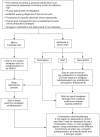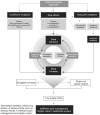Pharmacologic management of chronic pain
- PMID: 20556211
- PMCID: PMC2886242
- DOI: 10.3344/kjp.2010.23.2.99
Pharmacologic management of chronic pain
Abstract
Chronic pain is a multifactorial condition with both physical and psychological symptoms, and it affects around 20% of the population in the developed world. In spite of outstanding advances in pain management over the past decades, chronic pain remains a significant problem. This article provides a mechanism- and evidence-based approach to improve the outcome for pharmacologic management of chronic pain. The usual approach to treat mild to moderate pain is to start with a nonopioid analgesic. If this is inadequate, and if there is an element of sleep deprivation, then it is reasonable to add an antidepressant with analgesic qualities. If there is a component of neuropathic pain or fibromyalgia, then a trial with one of the gabapentinoids is appropriate. If these steps are inadequate, then an opioid analgesic may be added. For moderate to severe pain, one would initiate an earlier trial of a long term opioid. Skeletal muscle relaxants and topicals may also be appropriate as single agents or in combination. Meanwhile, the steps of pharmacologic treatments for neuropathic pain include (1) certain antidepressants (tricyclic antidepressants, serotonin and norepinephrine reuptake inhibitors), calcium channel alpha(2)-delta ligands (gabapentin and pregabalin) and topical lidocaine, (2) opioid analgesics and tramadol (for first-line use in selected clinical circumstances) and (3) certain other antidepressant and antiepileptic medications (topical capsaicin, mexiletine, and N-methyl-d-aspartate receptor antagonists). It is essential to have a thorough understanding about the different pain mechanisms of chronic pain and evidence-based multi-mechanistic treatment. It is also essential to increase the individualization of treatment.
Keywords: chronic pain; pharmacologic management.
Figures


References
-
- Kroenke K, Krebs EE, Bair MJ. Pharmacotherapy of chronic pain: a synthesis of recommendations from systematic reviews. Gen Hosp Psychiatry. 2009;31:206–219. - PubMed
-
- Varrassi G, Müller-Schwefe G, Pergolizzi J, Orónska A, Morlion B, Mavrocordatos P, et al. Pharmacological treatment of chronic pain - the need for CHANGE. Curr Med Res Opin. 2010;26:1231–1245. - PubMed
-
- Treede RD, Jensen TS, Campbell JN, Cruccu G, Dostrovsky JO, Griffin JW, et al. Neuropathic pain: redefinition and a grading system for clinical research purposes. Neurology. 2008;70:1630–1635. - PubMed
-
- Torrance N, Smith BH, Watson MC, Bennett MI. Medication and treatment use in primary care patients with chronic pain of predominantly neuropathic origin. Fam Pract. 2007;24:481–485. - PubMed
-
- Smith BH, Torrance N, Bennett MI, Lee AJ. Health and quality of life associated with chronic pain of predominantly neuropathic origin in the community. Clin J Pain. 2007;23:143–149. - PubMed
LinkOut - more resources
Full Text Sources
Miscellaneous
